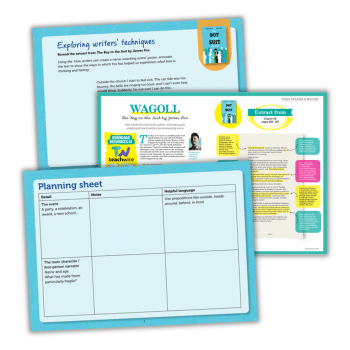Peer inside the mind of a professional author and help KS2 pupils understand how to build tension and write a nerve-wracking scene. This WAGOLL resource pack is based on The Boy in the Suit by James Fox.
This resource contains:
- Extract from The Boy in the Suit by James Fox
- ‘How writers can create a nerve-wracking scene’ poster
- ‘Exploring writers’ techniques’ worksheet
- ‘Exploring writers’ techniques’ working wall display
- Situation images
- Planning sheet
Your class will work towards planning and writing their own nerve-wracking scene, as experienced by a first-person narrator.
The challenge is to communicate the great stress of the narrator while keeping things light enough that
readers aren’t actually put off from reading.
Building tension KS2 tips
Comfort zones
Get to know your character’s safe space, then flip it upside down. If they love staying indoors, put them on a mountain during a storm. If they typically avoid the spotlight, put them on stage with a mic and a hostile audience.
Amp up the senses
Nervousness comes with distinct bodily sensations. Describe what your character is experiencing through sight, sound, touch, and smell. Hone in on body parts that may betray nervousness: a churning stomach, trembling hands, a rapid pulse.
Use rhetorical questions
Express doubt and concern by using rhetorical questions in thought and dialogue. Will it be okay? What’s going to happen? When will it be over? Answer these questions in the action.
Choose an imposing setting
Certain settings have anxiety built in. Choose one with an element of risk, danger, grandeur or tension to it. Describe it in detail and make it seem alien.
Describe the worst-case scenario
Have your character ruminate on their biggest fear. Is it fainting? Falling over? Describe their most dreaded outcomes in detail to create a vivid sense of anxiety
What is The Boy in the Suit about?
The Boy in the Suit is a middle-grade novel which follows ten-year-old Solo Walker and his complicated mum, Morag, as they struggle through the cost-of-living crisis.
As a means to survive, the duo sneak uninvited into strangers’ funerals, seeking food, warmth, and somewhere to be.
The title refers to the ill-fitting, second-hand suit Solo must wear to blend into the funeral crowd. Naturally, the pair are eventually caught gate-crashing, and their already precarious world is tipped on its side.
Solo, our main protagonist, must grapple with the impact of his parent’s decisions, while learning that sometimes grownups have fewer answers than children do.
Alongside their public shaming, he must learn to navigate family, school, and a budding friendship. Morag, embattled by failing mental health and media intrusion, is driven into hiding, leaving Solo to deal with problems that even adults scarcely know how to solve.
The story follows Solo and Morag as they transition from one normal to another, experiencing the good and the bad of the systems and community around them.
There are unexpected kindnesses, thoughtful gestures, funny moments, and occasional missteps and oversights by the people surrounding Solo.
Ultimately, the same systems and community come to their aid and help clear the path forwards with humour and care.
Thank you to Lindsay Pickton for creating the resource pack. Browse more WAGOLL packs from real authors.

Similar resources
- No Refuge – Graphic novel activities about refugees for UKS2
- Short story writing – Author-led resources for KS1 and KS2
- Christmas activity sheets – KS1 / KS2 fun & educational printables
- Learning gaps – How to ensure no pupil drifts too far
- Writing horror – Write a scary scene with Fear Files: Hide & Seek










